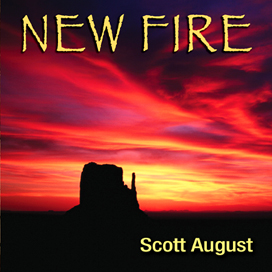
A lot of people ask me what flutes I use to record with. So I thought I'd take a moment and go through each CD over the next few months and talk about them in a little detail, starting with New Fire. I'll also talk a little about each track and link to previous posts about the track, flute or maker, if there are any.
Heart of the Sky
This piece is in the key of G with the flute in G pentatonic minor (from now on all keys are pentatonic minor (1-3-4-5-7) unless stated otherwise). The flute is a Scott Loomis flute.

Loomis G
This flute really sings and seemed to really fit the mood of this song. It's got a clear, singing tone with a touch of sweetness.
Heart of the Sky started out as a rhythm that I would improvise to. The original track was composed right after Distant Spirits but I didn't get down to recording the tune till much later. In fact in its first incarnation it was played on two flutes, one of which was a clay drone flute, and neither of these flutes were in G.
Heart of the Sky started out as a rhythm that I would improvise to. The original track was composed right after Distant Spirits but I didn't get down to recording the tune till much later. In fact in its first incarnation it was played on two flutes, one of which was a clay drone flute, and neither of these flutes were in G.
The title comes from my many visits to the Grand Canyon. The view from the rim seems to go on forever, to the heart of the sky.

One of the Mayan gods of creation was named Heart of Sky and there is also a Hopi deity named Heart of the Sky.
For a more detailed look at this flute visit my earlier post Loomis Native American flute
Recently I tend to play this song live on a J.P. Gomez aspen flute that I got after New Fire was finished. I still play the Loomis flute, but for this song J.P.'s seems to be better live. I've already recorded a piece for my fifth CD with this flute. J.P. lives in Sedona and makes excellent flutes. If you don't have one of his you should seriously consider adding one to your collection.
For a more detailed look at this flute visit my earlier post Loomis Native American flute
Recently I tend to play this song live on a J.P. Gomez aspen flute that I got after New Fire was finished. I still play the Loomis flute, but for this song J.P.'s seems to be better live. I've already recorded a piece for my fifth CD with this flute. J.P. lives in Sedona and makes excellent flutes. If you don't have one of his you should seriously consider adding one to your collection.
For a closer look at J.P. Gomez's flute visit Find out more about J.P. Gomez
Mockingbird Canyon
Key of F# played on a Moonlight Creek F# aspen flute. The opening tune for this piece popped into my head one day while practicing scales and technical exercises. Set against a rhythm of udus and tablas the tune is joined by an acoustic guitar, charrangos and other Latin guitar-like instruments. I like the crisp sound of aspen flutes, however they water out very quickly and take forever to dry.
Mockingbird Canyon is a real place in Chaco Canyon National Park, NM. Although the park is know for it's giant prehispanic buildings, Mockingbird Canyon is a quiet side canyon without any ancient structures that I know of.
I want to take a moment to talk about Moonlight Creek flutes by Michael Gulino. Michael is a good friend of mine having met him through flutes. He's never made a ton of flutes, but each one I own by him is a jewel. I don't have a favorite flute, but if I had to pick a favorite my G NAF by him would be on the short list of the flutes I might choose. Michael's flutes have a clarity and singing quality that is very rare in NAFs. Their thin walls give his flutes a very unique, yet classic sound. His flutes are completely made by hand. He doesn't even use a lathe to shape them but sands them down with sandpaper, by hand.
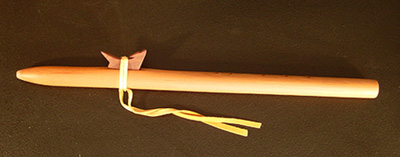
My Moonlight Creek G
It's hard to put into words, but in my mind the sound of Michael's flute embodies the haunting bittersweet sound of the NAF. The sound that captures peoples souls. Michael is a very talented person. He's always looking for new challenges. Sadly for the flute world he is not making many flutes and told me recently that when he sells what flutes he has left he plans to stop making them completely. Any one who owns one of Michael's wonderful instruments will understand me when I say this is a loss for the NAF world.
For a more in depth look at one of Michael's flutes see my earlier post on Gulino and Yazzie flutes
For a more in depth look at one of Michael's flutes see my earlier post on Gulino and Yazzie flutes
Turquoise Twilight
This piece is in G. I don't remember what flute I used on it. Seriously...
The title came to me during a drive from LA to Phoenix when the sun was sinking behind me and the sky all around was turning the many hues of turquoise, red, vermilion, salmon, pink, light blues, dark blues and black. The peaceful sensation from these colors seemed to match this piece perfectly.
The title came to me during a drive from LA to Phoenix when the sun was sinking behind me and the sky all around was turning the many hues of turquoise, red, vermilion, salmon, pink, light blues, dark blues and black. The peaceful sensation from these colors seemed to match this piece perfectly.
Ravens & Redtails
Another piece in G using the same Loomis flute from Heart of the Sky. This is another piece that began as a live sketch right after Distant Spirits to fill out my performances. When the mood strikes me I'll even perform the kalimba part live. The title comes from a road trip I took once where Ravens kept flying across the road and higher up in the sky above the highway Redtail hawks soared in the air currents. There are also lot of South American and Latin American guitars in this piece like Mockingbird Canyon.
New Fire
New Fire is the title track and was performed on a Queaztcoatzl double flute made by Guillermo Martinez. This particular flute was one of his first doubles and is marked #2 on the back. I showed it to him a few years ago and he didn't remember making it, but I purchased it directly from him.
Made of what looks to be yellow cedar, this flute is tuned in 4ths and has metal "nests" for the totems or birds to rest on.
This is another piece that started as a rhythm for live performances to improvise on top of, which I then expanded into a larger piece. Ironically I still use the original "live" version in concert and never switched over to the version that's on the CD.
Made of what looks to be yellow cedar, this flute is tuned in 4ths and has metal "nests" for the totems or birds to rest on.
This is another piece that started as a rhythm for live performances to improvise on top of, which I then expanded into a larger piece. Ironically I still use the original "live" version in concert and never switched over to the version that's on the CD.
The name New Fire comes from the New Fire ceremony which is performed by many the Hopi as part of the large Wuwuchim ceremony. Simply put it is a New Years ceremony, but in reality it is much more complex than that. It has a long history and a version of it dates back to Aztec times when it was performed every 52 years. Jessie Walter Fewkes, an American anthropologist, archaeologist, writer who supervised excavations at Mesa Verde, thought that evidence exists indicating that the New Fire ceremony was performed at Mesa Verde during the 10th and 11th centuries.
Sedona Sunrise
This piece is the only flute solo on New Fire and was performed on a Yazzie flute made of Cocobolo.

Yazzie cocobolo flute
Cocobolo is part of the Rosewood family, which is used a lot in instrument construction. Guitars are know for having parts of them made with Rosewood.
This piece was recorded before the title came to me. This is usually how it works. Just after I had finished the song I was visiting Sedona and driving early one morning to an appearance I was doing in the area. The rays of the sun were low in the sky and the cliffs were bright red and pink, as if they were lighted from the inside.
This piece was recorded before the title came to me. This is usually how it works. Just after I had finished the song I was visiting Sedona and driving early one morning to an appearance I was doing in the area. The rays of the sun were low in the sky and the cliffs were bright red and pink, as if they were lighted from the inside.

Read more about the Yazzie Cocobolo flute.
Cactus Dance
Sometimes ideas come during time when you don't expect them to. The seed for this song was planted during a concert I gave years ago while I was demonstrating different kinds of flutes. I spent just a few minutes talking about non standard Native American flutes: Clay flutes, drone flutes, double flutes, bass flutes... Anything that the average person might not have seen before.
One of the flutes I demonstrated was a High Spirits drone. High Spirit drone are joined at the mouthpiece and then flare out like a "V". This particular flute had an altered drone tuning which could be exploited to great effect. I played a short but fast little improvisation through a very bouncy delay. At that time I was recording all my performances and when I got back to my studio it seemed that there was the beginnings of piece there. So a few months later when I got the chance I developed it into a real piece.
One of the flutes I demonstrated was a High Spirits drone. High Spirit drone are joined at the mouthpiece and then flare out like a "V". This particular flute had an altered drone tuning which could be exploited to great effect. I played a short but fast little improvisation through a very bouncy delay. At that time I was recording all my performances and when I got back to my studio it seemed that there was the beginnings of piece there. So a few months later when I got the chance I developed it into a real piece.
Cactus Dance bounces along with a very energetic rhythm with a middle section that pulls back and becomes more dreamy. There are hints of Andean music throughout the piece.
The version on the album was recorded using the High Spirits flute and for a while I was dragging that instrument around to perform the song live. However, given it's V shape it wouldn't fit into my flute bags and caused me to have to carry it around in a cardboard box. This got to be a pain, the box started to fall apart and a couple times the flute fell out.
The version on the album was recorded using the High Spirits flute and for a while I was dragging that instrument around to perform the song live. However, given it's V shape it wouldn't fit into my flute bags and caused me to have to carry it around in a cardboard box. This got to be a pain, the box started to fall apart and a couple times the flute fell out.
Due to this I had stopped playing the song live until Richard Halliburton sent me plans for a flute he was asked to make by one of his customers. I never could figure out what that flute was for. It was in a very odd tuning and scale. However, when I looked at it I saw that if he made it in the normal (so called) minor pentatonic scale, the 1-3-4-5-7 pentatonic, I would have a flute that would look like other drones but would have the altered drone tuning I wanted. So now I can play Cactus Dance live again but on Rich's flute.
Rich is an up and coming flute maker from the LA area. One of his flute won first place at the first Oklahoma Flute festival and they are quite striking. He uses a lot of onlay, inlay and semi precious gemstones in his flutes.
Rich is an up and coming flute maker from the LA area. One of his flute won first place at the first Oklahoma Flute festival and they are quite striking. He uses a lot of onlay, inlay and semi precious gemstones in his flutes.

The Rich Halliburton drone
The title for this song comes from it's South American influence and my memories of visiting far southern Arizona. There cactus are everywhere. Barrel, Cholla, Saguaro abound. The rays of early morning and late afternoon sunlight dancing on their spines.
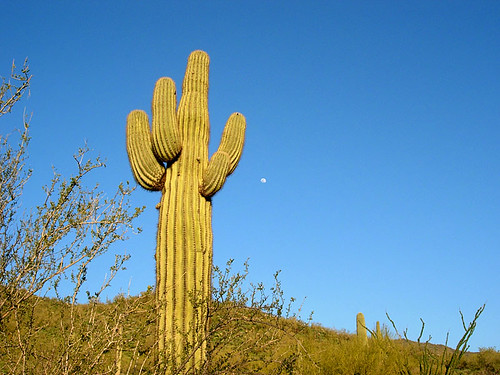
To read more about this piece and to learn more about Rich Halliburton and the flutes used on Cactus Dance visit Two Tunable Drones
Sombra de La Luna
Performed on a clay "Moon Goddess flute made by Xavier Quijas Yxayotl.
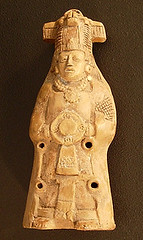
Clay flutes were very common in the ancient Mexican and the Mayan cultures. Excavations and early accounts show evidence for this. I have seen photos of a pit used for offering and clay flutes with a trumpet shaped bells are among the many objects that were throw in the pit to the Gods. Clay flutes do not have the front chamber that Native American flutes have but instead have the flue placed in the mouthpiece. This is the more common type of construction for fipple flutes. NAFs are the exception to the rule.
Once again this piece got it's start from a live improve I gave once. Originally I recorded a solo version of it for Sacred Dreams but I felt that there was still much more that could be done with the tune and the sound of the flute so I rearranged a version that was longer and had more instruments. This is the version on New Fire which combines the flute with piano, some treated percussion and very atmospheric tones.
Take a closer look at this flute
Temple of the Sun
Recorded on a Guillermo Martinez double flute Temple of the Sun is the longest piece on New Fire. It begins with a solo and is later joined by a hypnotic percussion beat over the quiet drone of didgeridoos.

The flute is made of wood and the longer half is tuned to D while the shorter half is tuned to A.
I posted an in-depth article about this flute which is still accessible.
I posted an in-depth article about this flute which is still accessible.
Ancient Memories
Although this tune comes later in sequence on the disc it was the first to be composed for New Fire. I had just obtained a Hawk and Geri Littlejohn bass G flute and my first Yazzie flute having just met them. I thought it would be fun to write a piece for a flute and it's bass counterpart.
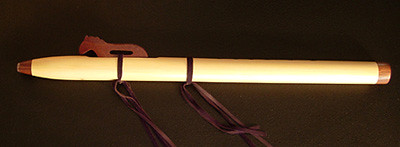
Yazzie G flute
Right after Distant Spirits came out I was asked to do a workshop for the NCFC on recording a NAF with a computer. I used this piece in that workshop since it was still in production.
Sacred Night
This is the only piece on New Fire where the flute was recorded live during a performance, taken back to the studio where the rest of the instruments were added to it. The piece is in D#/Eb and is played on a Ken Light flute. This is my favorite Ken Light flute. It has a good clean sound but with just a little buzz for character. The fingering on mine is not his usual fingering but the standard NAF fingering of playing the octave by holding down the fourth hole from the bottom.
The flute part itself was an improvisation to which the other parts were layered in weeks later. This is always a fun way to work for me as I enjoy the challenge of working around a recording that is locked down. I did do some processing toward the end where the flute returns as a faint echo in a texture of sounds.
In my mind as I was working on this piece was the memory of a trip I made to Flagstaff, passing through Keyenta, or K-Town as the locals call it, and Tuba city on Hwy 160. The road passes through Tsegi, Shonto, Cow Springs and Tonalea on the north while the cliffs of Black Mesa rise to the south. As the sun began to touch the horizon the sky began to light up in multi chromatic hues.
I began to take photos of the changing scenery and light while driving down the highway. It was one of the most beautiful sunsets I've ever seen and Arizona is known for it's beautiful sunsets. One of the shots made it into the booklet for New Fire.
Well, that's a look at New Fire. We'll look at my other CDs in the near future.
© CEDAR MESA MUSIC. THIS ARTICLE AND ALL IMAGES AND SOUND FILES ARE THE PROPERTY OF CEDAR MESA MUSIC. ALL RIGHTS RESERVED. UNAUTHORIZED DUPLICATION (COPYING) IN ANY FORM IS ILLEGAL AND IS A VIOLATION OF ALL COPYRIGHT LAWS. THIS INCLUDES, BUT IS NOT LIMITED TO, USING ON YOUR BLOG OR MYSPACE PAGE.
The flute part itself was an improvisation to which the other parts were layered in weeks later. This is always a fun way to work for me as I enjoy the challenge of working around a recording that is locked down. I did do some processing toward the end where the flute returns as a faint echo in a texture of sounds.
In my mind as I was working on this piece was the memory of a trip I made to Flagstaff, passing through Keyenta, or K-Town as the locals call it, and Tuba city on Hwy 160. The road passes through Tsegi, Shonto, Cow Springs and Tonalea on the north while the cliffs of Black Mesa rise to the south. As the sun began to touch the horizon the sky began to light up in multi chromatic hues.
I began to take photos of the changing scenery and light while driving down the highway. It was one of the most beautiful sunsets I've ever seen and Arizona is known for it's beautiful sunsets. One of the shots made it into the booklet for New Fire.
Well, that's a look at New Fire. We'll look at my other CDs in the near future.
© CEDAR MESA MUSIC. THIS ARTICLE AND ALL IMAGES AND SOUND FILES ARE THE PROPERTY OF CEDAR MESA MUSIC. ALL RIGHTS RESERVED. UNAUTHORIZED DUPLICATION (COPYING) IN ANY FORM IS ILLEGAL AND IS A VIOLATION OF ALL COPYRIGHT LAWS. THIS INCLUDES, BUT IS NOT LIMITED TO, USING ON YOUR BLOG OR MYSPACE PAGE.
This is totally and absolutely marvelous! Especially with a few extra treats of beautiful pictures, ravens flying around an arch and a snippet of a live performance. I think a lot of us have been curious as to which flute went with what song. Thank you for this!
ReplyDeleteThe sound of your flute(s) is fabulous. I've added your blog to my blog list. Is there a way I could add some of your music?
ReplyDelete